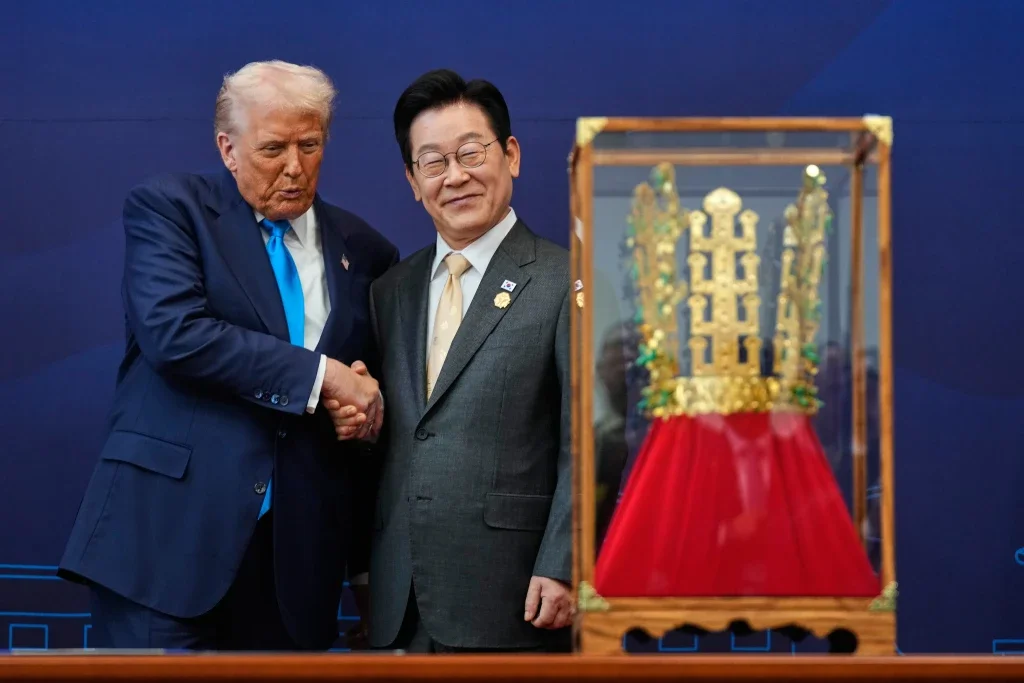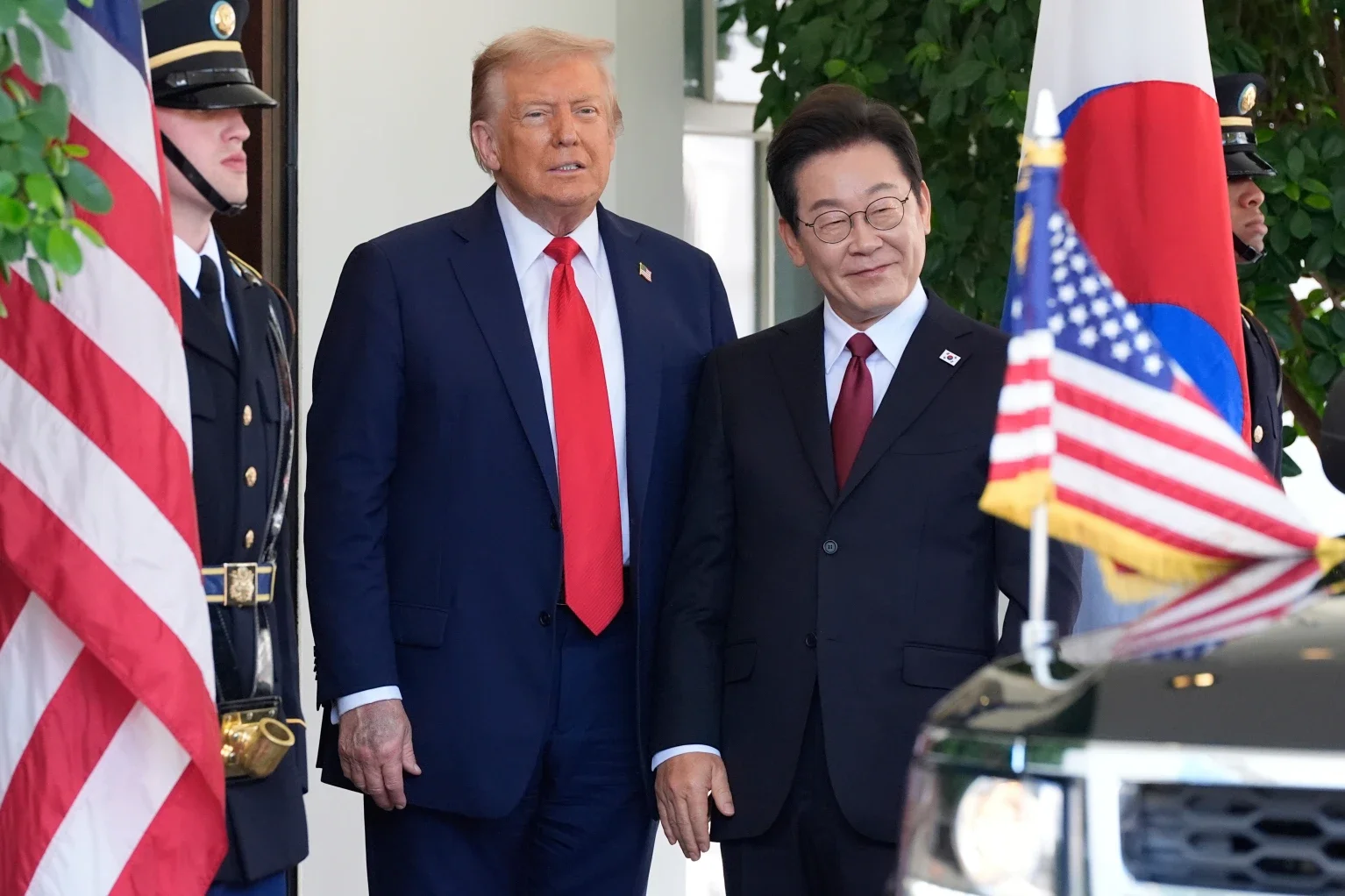After Trump’s ‘Dry in the U.S.’ remark, South Korea’s nuclear submarine debate reignites entirely
President Donlad Trump shakes hands with South Korean President Lee Jae Myung as he receives a gift of gold crown and an award of the Grand Order of Mugungwha, not seen, during a high honor ceremony at the Gyeonju National Museum in Gyeongju, South Korea, Wednesday, Oct. 29, 2025. Photo: AP News
As U.S. President Donald Trump stated, “South Korea will build nuclear-powered submarines at the Philadelphia Shipyard in the U.S.,” it is evaluated that South Korea’s discussion on the introduction of nuclear-powered submarines has entered a full-fledged phase. Currently, the South Korean government and military authorities have been considering developing nuclear submarines that use less than 20% “low-enriched uranium (LEU)” fuel, but it is pointed out that other options should be discussed as President Trump himself talks about the possibility of “building in the U.S.”
Although low-enriched uranium requires fuel replacement every 10 years, more than 90% of highly enriched uranium (HEU) fuels do not require fuel rods to be replaced during the reactor’s lifespan, which greatly increases design and operation efficiency. However, the U.S. has been extremely careful about transferring HEU to South Korea on the grounds that it may be used for nuclear weapons, which requires revision of U.S. domestic nuclear laws or separate legislative action. The process of persuading nonproliferationists in the U.S. administration and Congress is also a difficult challenge.
In this photo provided by the South Korea Defense Ministry, U.S. Defense Secretary Pete Hegseth, center right, and South Korean Defense Minister Ahn-Gyu-back, center left, visit the Observation Post Ouellette near the border village of Panmunjom, South Korea, Monday, Nov. 3, 2025. Photo: AP News
Until now, highly enriched uranium was believed to be difficult to introduce in the United States because it could be diverted to develop nuclear weapons. In order to transfer U.S. nuclear fuel and technology, it is necessary to amend the U.S. nuclear law or to legislate separately to control these materials and technologies. As mentioned, to persuade non-proliferationists within the U.S. government remains a challenge. Some suggest that President Trump acknowledges South Korea’s introduction of nuclear weapons and that China, Russia, and North Korea should take advantage of the situation in which the latter three are accelerating their naval power.
In addition to these technical and legal issues, the introduction of nuclear-powered submarines is a sensitive issue that shakes the entire strategic environment in Northeast Asia. China is expected to strongly protest South Korea’s push for nuclear-powered submarines, and is likely to see it as a “factor that changes the regional naval balance”, while Japan has raised concerns that Seoul’s acquisition could affect its own defense planning. There is a prospect that North Korea can also justify further nuclear and missile development using South Korea’s pursuit of nuclear submarines as an excuse.
Even domestically, the introduction of nuclear-powered submarines is not only a military technology project but also a political issue that directly relates to strategic autonomy. The South Korean government is suggesting that securing long-term submarine capabilities in waters around the Korean Peninsula and improving anti-submarine operational efficiency are the main necessity of its nuclear push. However, opposition parties are raising caution over possible collision of the Non-Proliferation System (NPT), deepening of the industrial structure subordinate to the U.S., and accelerating an arms race with neighboring countries.
In particular, the issue of the submarine construction site is an issue that reveals Korea’s technological sovereignty and the industrial nature of the Korea-U.S. alliance at the same time. There is an analysis that President Trump’s emphasis on building shipyards in the U.S. is strong in terms of creating jobs in the U.S. and protecting the military industry, but South Korea has already maintained its position to stick to domestic construction because it has the world’s best capabilities to build warships and submarines. Depending on the location of the shipbuilding, the scope of technology transfer, equity structure, and maintenance system can vary greatly, which is expected to be a key issue in future negotiations.
President Donald Trump, left, greets South Korean President Lee Jae Myung upon his arrival at the White House, Washington, Monday, Aug. 25, 2025. Photo: AP News
Experts believe that South Korea’s introduction of nuclear submarines will strengthen the military ties of the Korea-U.S. alliance and that South Korea will take on greater strategic responsibility. This is because if the United States provides HEU to South Korea, it could actually raise ‘South Korea’s potential nuclear armament capability’ back to the international community. It is difficult to rule out the possibility that China, Russia, and North Korea will use it as a justification for intensifying regional arms competition.
As such, the issue of introducing nuclear-powered submarines is a complicated issue of technology, late, alliance, and regional security, and the direction of the strategic order in Northeast Asia is expected to change significantly depending on what form of joint announcement the U.S. and South Korea will make in the future.



